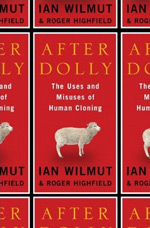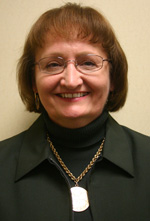Review of "After Dolly: The Uses and Misuses of Human Cloning"

Author(s): Ian Wilmut and Roger Highfield
Published: June 12, 2006, W.W. Norton & Company, ISBN: 0393060667
 by Carol H. Weaver, Ph.D., Associate Professor of Biology
by Carol H. Weaver, Ph.D., Associate Professor of Biology
September 251, 2006 -
Early in 1997, the shocking news hit. A little Finn-Dorset lamb was born to a Scottish Blackface ewe in Roslin, a Scottish town primarily known at the time for its ornately carved, Holy Grail-connected Rosslyn Chapel. But with the birth of this baby, Roslin also became marked as the site of a remarkable scientific achievement, for the lamb was the first mammal to be cloned from an adult cell.
The lamb, begun from a mammary cell from an adult ewe and named Dolly after the well-endowed country music singer, became an instant celebrity. As soon as Dolly’s birth was announced, scientists and the general public alike were startled into wondering what would come after Dolly. Would a human be cloned? How would such a step affect society? What would happen to Dolly as she herself grew up?
In the ten years since Dolly arrived, other mammals have been cloned, but not a human. It took 277 attempts to get one Dolly and until now, the risks involved in cloning have been viewed as too great to apply to humans. However, the idea of therapeutic cloning, which uses stem cells from embryos cloned from patients, has had less clear cut prohibitions, and there is no lack of scientists who want to study it. This has proved to be the thinking of Ian Wilmut, the Roslin scientist heading the group who produced Dolly, and this book carefully maps out Wilmut’s reasoning.
Wilmut has become a rather reluctant celebrity himself, and in his book he is quick to give credit to his team and take a more humble position for himself. Nevertheless, since fame has found him, he has chosen the vehicle of this book to make his case for therapeutic cloning and against human, or reproductive, cloning. In a writing style easy for almost anyone to read, Wilmut outlines his point of view beginning with a brief history of cloning in which he also takes a look at other clones. He very firmly gives many reasons that human cloning should not be done, but also proposes that therapeutic cloning would be a great benefit to society.
In a chapter devoted to nixing human cloning, Wilmut repeatedly points out that cloning has deleterious effects. In sheep, reconstructed embryos grow more slowly and ewes are pregnant longer, and the ewes don’t give clues such as nesting to indicate an impending birth. Abnormalities commonly occur including development of an overweight fetus with oversize blood vessels that make the newborn unable to breathe, failure of the immune system to develop, and abnormal development of various organs. After birth, cloned animals are not as viable and as many as 40% of cloned lambs don’t survive more than a few weeks. These dismal statistics alone speak against human cloning, but Wilmut also provides societal reasons. And due to epigenetics, a clone cannot be guaranteed to be exactly like the donor as was demonstrated undisputedly by CC the cloned calico who looked nothing like the calico which donated the nuclear material. Nature may be important, but nurture also plays an essential role in making a person who he or she really is.
On the other hand, Wilmut wants studies on therapeutic cloning to proceed and passionately defends this point of view. Considering the objections made by those who value the personhood of an embryo, he states that “the status of the blastocyst is the one thing that everyone can disagree on.” Is the blastocyst a person if it has no mental life? Is it capable of valuing its own existence? The cells making up the blastocyst are undifferentiated, therefore having no way of feeling pain, so should the development of the primitive streak at 14 days be the cutoff point for work on embryos? In his words, society must “respect the early embryo and have duties to it, but I passionately believe these are overridden by the duty we have to people.”
He also questions the idea that we as a society should not do “unnatural” things. But what is natural? He points out that we air condition our homes, drive to work, and take acetaminophen for headaches and view these events are perfectly natural. He wonders in this context how therapeutic cloning could be seen as “not natural” to the extent of not doing it.
In the years after Dolly, society has of necessity been forced into public debate on its stance on the question of cloning. “Society has to weigh the opportunities to help and make sure that it does not miss important new opportunities because of fear of new knowledge. We should expect to change our views and judgments in the light of new discoveries,” Wilmut writes.
Regardless of one’s own viewpoint on the questions of reproductive and therapeutic cloning, this book provides an insider’s look into an exciting and controversial area of biology. Journalists have been using their words to describe what Wilmut is like, what his motivations are, and what his history has been since he was thrust in the spotlight along with Dolly; but, with After Dolly, the reader will have the chance to listen to Wilmut himself.

